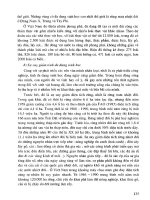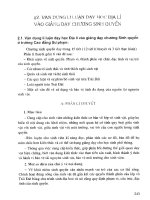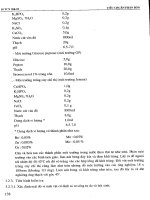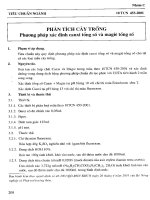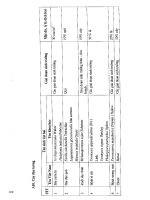CNNA3-Chapter 3: Part II pot
Bạn đang xem bản rút gọn của tài liệu. Xem và tải ngay bản đầy đủ của tài liệu tại đây (1.55 MB, 39 trang )
CCNA3-1
Chapter 3-2
Chapter 3
Chapter 3
Virtual Local Area Networks
Virtual Local Area Networks
(VLANs)
(VLANs)
Part II
Part II
CCNA3-2
Chapter 3-2
Virtual Local Area Networks
Virtual Local Area Networks
VLAN Trunking
VLAN Trunking
CCNA3-3
Chapter 3-2
VLAN Trunking
VLAN Trunking
•
The concept of
The concept of
trunking
trunking
began with the telephone industry.
began with the telephone industry.
•
Multiple calls were moved between customers and central
Multiple calls were moved between customers and central
offices or between the offices themselves over a single
offices or between the offices themselves over a single
physical connection.
physical connection.
CCNA3-4
Chapter 3-2
VLAN Trunking
VLAN Trunking
•
The same principle was applied to data communications to
The same principle was applied to data communications to
make better use of the communication line.
make better use of the communication line.
•
Additional advantages and cost savings were gained by
Additional advantages and cost savings were gained by
using the same line for voice communications.
using the same line for voice communications.
24 Channel T1 Line
with Data and Voice
CCNA3-5
Chapter 3-2
VLAN Trunking
VLAN Trunking
•
The same principle of trunking is applied to network switching
The same principle of trunking is applied to network switching
technologies.
technologies.
•
A trunk
A trunk
is a
is a
physical and logical
physical and logical
connection between two
connection between two
switches across which network traffic travels.
switches across which network traffic travels.
No trunk
No trunk
No trunk
No trunk
Trunk
Trunk
Trunk
Trunk
CCNA3-6
Chapter 3-2
VLAN Trunking
VLAN Trunking
•
It is also important to
It is also important to
realize that a trunk link
realize that a trunk link
does not belong
does not belong
to a
to a
specific VLAN.
specific VLAN.
•
The responsibility of a
The responsibility of a
trunk link is to act as a
trunk link is to act as a
conduit
conduit
for VLANs.
for VLANs.
•
Between
Between
switches
switches
and
and
routers
routers
.
.
•
Between
Between
switches
switches
and
and
switches
switches
.
.
CCNA3-7
Chapter 3-2
VLAN Trunks
VLAN Trunks
•
What problem does it solve?
What problem does it solve?
Network 172.17.10.0/24
Network 172.17.10.0/24
Network 172.17.10.0/24
Network 172.17.10.0/24
Network 172.17.20.0/24
Network 172.17.20.0/24
Network 172.17.20.0/24
Network 172.17.20.0/24
Network 172.17.99.0/24
Network 172.17.99.0/24
Network 172.17.99.0/24
Network 172.17.99.0/24
Network 172.17.30.0/24
Network 172.17.30.0/24
Network 172.17.30.0/24
Network 172.17.30.0/24
CCNA3-8
Chapter 3-2
IEEE 802.1Q Frame Tagging
IEEE 802.1Q Frame Tagging
•
Remember that switches are Layer 2 devices.
Remember that switches are Layer 2 devices.
•
Only use the Ethernet frame header information.
Only use the Ethernet frame header information.
•
Frame header does not contain information about VLAN
Frame header does not contain information about VLAN
membership.
membership.
•
VLAN membership (i.e. VLAN ID or VLAN Number) must be
VLAN membership (i.e. VLAN ID or VLAN Number) must be
identified for each frame that is transferred over the trunk.
identified for each frame that is transferred over the trunk.
•
The process is called
The process is called
802.1Q VLAN Tagging.
802.1Q VLAN Tagging.
CCNA3-9
Chapter 3-2
IEEE 802.1Q Frame Tagging
IEEE 802.1Q Frame Tagging
6 6 2 1500 4
Destination
Address
Source
Address
Type /
Length
Data
Max of 1500 Bytes
FCS
6 6 2 2 2 1500 4
Destination
Address
Source
Address
802.1Q Tag
Type/
Length
Data
Max of 1500 Bytes
New
FCS
8100 Tag
Length 1518 Bytes
Length 1518 Bytes
Length 1518 Bytes
Length 1518 Bytes
Length 1522 Bytes
Length 1522 Bytes
Length 1522 Bytes
Length 1522 Bytes
CCNA3-10
Chapter 3-2
6 6 2 2 2 1500 4
Destination
Address
Source
Address
802.1Q Tag
Type/
Length
Data
Max of 1500 Bytes
New
FCS
8100 Tag
IEEE 802.1Q Frame Tagging
IEEE 802.1Q Frame Tagging
Length 1522 Bytes
Length 1522 Bytes
Length 1522 Bytes
Length 1522 Bytes
3 Bits
3 Bits
1 Bit
1 Bit
12 Bits
12 Bits
User
User
Priority
Priority
CFI
CFI
VLAN ID
VLAN ID
Canonical Format Identifier
Canonical Format Identifier
Canonical Format Identifier
Canonical Format Identifier
CCNA3-11
Chapter 3-2
Native VLANs
Native VLANs
•
Tagged Frames on the native VLAN.
Tagged Frames on the native VLAN.
•
Some devices that support trunking tag native VLAN traffic
Some devices that support trunking tag native VLAN traffic
as a default behavior.
as a default behavior.
•
Control traffic sent on the native VLAN should be
Control traffic sent on the native VLAN should be
untagged.
untagged.
•
If an 802.1Q trunk port receives a tagged frame on the
If an 802.1Q trunk port receives a tagged frame on the
NATIVE
NATIVE
VLAN ONLY
VLAN ONLY
,
,
it drops the frame
it drops the frame
.
.
•
When configuring a switch port on a Cisco switch, you
When configuring a switch port on a Cisco switch, you
need to
need to
identify these devices and configure them
identify these devices and configure them
so
so
that they
that they
do not send tagged frames
do not send tagged frames
on the native
on the native
VLAN.
VLAN.
•
Devices from
Devices from
other vendors
other vendors
that support tagged frames
that support tagged frames
on the native VLAN include
on the native VLAN include
IP phones, servers,
IP phones, servers,
routers, and switches
routers, and switches
.
.
CCNA3-12
Chapter 3-2
Native VLANs
Native VLANs
•
Un-Tagged Frames on the native VLAN.
Un-Tagged Frames on the native VLAN.
•
When a Cisco switch trunk port receives untagged frames
When a Cisco switch trunk port receives untagged frames
it forwards those frames to the native VLAN.
it forwards those frames to the native VLAN.
•
Default native VLAN is VLAN 1.
Default native VLAN is VLAN 1.
•
When you configure an 802.1Q trunk port, a
When you configure an 802.1Q trunk port, a
default Port VLAN ID (PVID)
default Port VLAN ID (PVID)
is assigned the
is assigned the
value of the
value of the
native VLAN
native VLAN
.
.
•
All untagged traffic coming in or out of the 802.1Q port is
All untagged traffic coming in or out of the 802.1Q port is
forwarded
forwarded
based on the PVID value
based on the PVID value
.
.
CCNA3-13
Chapter 3-2
Native VLANs
Native VLANs
•
Configure the trunk to default to native VLAN 1.
Configure the trunk to default to native VLAN 1.
•
Configure the trunk for native VLAN 99.
Configure the trunk for native VLAN 99.
CCNA3-14
Chapter 3-2
Native VLANs
Native VLANs
•
Verify the configuration.
Verify the configuration.
•
VLAN 50 is a voice VLAN.
VLAN 50 is a voice VLAN.
CCNA3-15
Chapter 3-2
Trunking Operation
Trunking Operation
PC1 and PC3
PC1 and PC3
send a broadcast.
send a broadcast.
PC1 and PC3
PC1 and PC3
send a broadcast.
send a broadcast.
10
10
10
10
20
20
20
20
30
30
30
30
10
10
10
10
20
20
20
20
30
30
30
30
S2 receives the frames and
S2 receives the frames and
‘tags’ them with the VLAN ID.
‘tags’ them with the VLAN ID.
S2 receives the frames and
S2 receives the frames and
‘tags’ them with the VLAN ID.
‘tags’ them with the VLAN ID.
The tagged frames are sent
The tagged frames are sent
across the trunk links between
across the trunk links between
S2 and S1 and S1 and S3.
S2 and S1 and S1 and S3.
The tagged frames are sent
The tagged frames are sent
across the trunk links between
across the trunk links between
S2 and S1 and S1 and S3.
S2 and S1 and S1 and S3.
S3 strips the tags and
S3 strips the tags and
forwards to the destination.
forwards to the destination.
S3 strips the tags and
S3 strips the tags and
forwards to the destination.
forwards to the destination.
CCNA3-16
Chapter 3-2
Trunking Modes
Trunking Modes
•
A Cisco switch can be configured to support
A Cisco switch can be configured to support
two types
two types
of
of
trunk ports:
trunk ports:
•
IEEE 802.1Q
IEEE 802.1Q
•
ISL
ISL
(Inter-Switch Link)
(Inter-Switch Link)
•
Today only 802.1Q is used.
Today only 802.1Q is used.
•
Legacy networks may still use ISL.
Legacy networks may still use ISL.
CCNA3-17
Chapter 3-2
Trunking Modes
Trunking Modes
•
IEEE 802.1Q:
IEEE 802.1Q:
•
Assigned a default PVID.
Assigned a default PVID.
•
Supports simultaneous tagged and untagged traffic.
Supports simultaneous tagged and untagged traffic.
•
Untagged traffic:
Untagged traffic:
•
Associated with the port default PVID.
Associated with the port default PVID.
•
Null VLAN ID traffic belongs to the default PVID.
Null VLAN ID traffic belongs to the default PVID.
•
Tagged traffic:
Tagged traffic:
•
VLAN ID equal to the outgoing port default PVID is
VLAN ID equal to the outgoing port default PVID is
sent untagged.
sent untagged.
•
Null VLAN ID traffic belongs to the default PVID.
Null VLAN ID traffic belongs to the default PVID.
•
All other traffic is sent with a VLAN tag.
All other traffic is sent with a VLAN tag.
CCNA3-18
Chapter 3-2
Trunking Modes
Trunking Modes
•
ISL (Inter-Switch Link):
ISL (Inter-Switch Link):
•
All received packets are
All received packets are
expected to be encapsulated
expected to be encapsulated
with an ISL header.
with an ISL header.
•
All transmitted packets are sent with an ISL header.
All transmitted packets are sent with an ISL header.
•
Untagged frames received from an ISL trunk port are
Untagged frames received from an ISL trunk port are
dropped.
dropped.
•
No longer recommended or supported
No longer recommended or supported
.
.
•
30 bytes of overhead for each frame…
30 bytes of overhead for each frame…
CCNA3-19
Chapter 3-2
Trunking Modes
Trunking Modes
•
Dynamic Trunking Protocol (DTP):
Dynamic Trunking Protocol (DTP):
•
Cisco proprietary protocol.
Cisco proprietary protocol.
Switches from other vendors
Switches from other vendors
do not support DTP.
do not support DTP.
•
Automatically enabled on a switch port
Automatically enabled on a switch port
when certain
when certain
trunking modes are configured
trunking modes are configured
on the switch port.
on the switch port.
•
DTP manages trunk negotiation
DTP manages trunk negotiation
only if the port on the
only if the port on the
other switch
other switch
is configured in a trunk mode that supports
is configured in a trunk mode that supports
DTP.
DTP.
•
DTP supports both ISL and 802.1Q trunks.
DTP supports both ISL and 802.1Q trunks.
•
Some Cisco switches and routers (older versions) do not
Some Cisco switches and routers (older versions) do not
support DTP.
support DTP.
CCNA3-20
Chapter 3-2
Trunking Modes
Trunking Modes
•
Dynamic Trunking Protocol (DTP):
Dynamic Trunking Protocol (DTP):
•
On (default):
On (default):
(
(
switchport mode trunk
switchport mode trunk
)
)
•
Periodically sends DTP advertisements, to the remote
Periodically sends DTP advertisements, to the remote
port that it is dynamically changing to a trunking state.
port that it is dynamically changing to a trunking state.
•
Dynamic Auto:
Dynamic Auto:
(
(
switchport mode dynamic auto
switchport mode dynamic auto
)
)
•
The switch port periodically sends DTP frames to the
The switch port periodically sends DTP frames to the
remote port. It advertises to the remote switch port that
remote port. It advertises to the remote switch port that
it is
it is
able to trunk
able to trunk
but does not request to go to the
but does not request to go to the
trunking state.
trunking state.
•
Dynamic Desirable:
Dynamic Desirable:
(
(
switchport mode dynamic desirable
switchport mode dynamic desirable
)
)
•
DTP frames are sent periodically to the remote port. It
DTP frames are sent periodically to the remote port. It
advertises to the remote switch port that it is
advertises to the remote switch port that it is
able to trunk
able to trunk
and
and
asks the remote switch port
asks the remote switch port
to go to the trunking state.
to go to the trunking state.
CCNA3-21
Chapter 3-2
Trunking Modes
Trunking Modes
•
Dynamic Trunking Protocol (DTP):
Dynamic Trunking Protocol (DTP):
•
Turn off DTP:
Turn off DTP:
(
(
switchport nonegogiate
switchport nonegogiate
)
)
•
The local port does not send out DTP frames to the
The local port does not send out DTP frames to the
remote port.
remote port.
•
The local port is then considered to be in an
The local port is then considered to be in an
unconditional trunking
unconditional trunking
state.
state.
•
Use this feature when you need to configure a trunk
Use this feature when you need to configure a trunk
with a switch from another switch vendor
with a switch from another switch vendor
.
.
CCNA3-22
Chapter 3-2
Virtual Local Area Networks
Virtual Local Area Networks
Configure VLANs and Trunks
Configure VLANs and Trunks
CCNA3-23
Chapter 3-2
Configure VLANs and Trunks
Configure VLANs and Trunks
•
Overview:
Overview:
1.
1.
Create the VLANs.
Create the VLANs.
2.
2.
Assign switch ports to VLANs statically.
Assign switch ports to VLANs statically.
3.
3.
Verify VLAN configuration.
Verify VLAN configuration.
4.
4.
Enable trunking on the inter-switch connections.
Enable trunking on the inter-switch connections.
5.
5.
Verify trunk configuration.
Verify trunk configuration.
CCNA3-24
Chapter 3-2
Configure a VLAN
Configure a VLAN
•
Command Syntax:
Command Syntax:
S1#
S1#
configure terminal
configure terminal
S1(config)#
S1(config)#
vlan
vlan
vlan id
vlan id
S1(config-vlan)#
S1(config-vlan)#
name
name
vlan name
vlan name
S1(config-vlan)#
S1(config-vlan)#
end
end
CCNA3-25
Chapter 3-2
Configure a VLAN
Configure a VLAN
Configure a VLAN
Configure a VLAN
Configure a VLAN
Configure a VLAN




